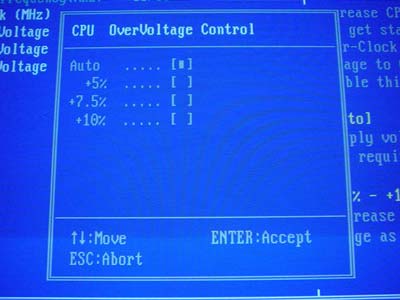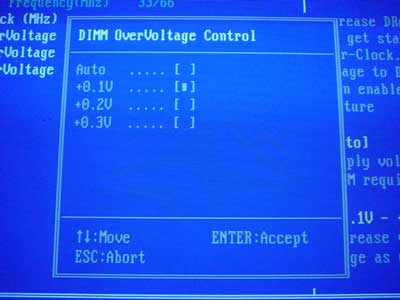Gigabyte 7VAXP-A Ultra: The KT400A in Retail Action
by Evan Lieb on March 31, 2003 3:19 AM EST- Posted in
- Motherboards
Vcore flexibility is quite good, adjustable as high as 1.815V in 2.5% and 5.0% increments. In fact, default Vcore fluctuates a bit higher, around 1.69V with a 1.65V Thoroughbred-B processor. So in reality, you should be able to hit over 1.85V with this board if you dare go that high. If you plan on keeping your processor for any good period of time, we suggest that you not run your CPU at 1.85V.

Thankfully there are a slew of CPU multiplier options in the 7VAXP-A Ultra BIOS, available from 5X to 18X. This, of course, allowed us to isolate the FSB on the 7VAXP-A Ultra to make sure the motherboard limited the FSB and not the CPU. In case you're wondering, there are onboard switches that allow adjustment of the CPU's multiplier in the BIOS just like the ones found on the previous generation Socket A VIA motherboard from Gigabyte, the 7VAXP Ultra - our review of this motherboard can be found here.

VDIMM is yet another adjustable option in the 7VAXP-A Ultra's BIOS, available up to 2.8V in 0.1V increments. This should please lots of memory overvolters, as anything over 2.8V can damage your memory in the long-term anyway.
Unfortunately there wasn't an AGP/PCI lock available in the 7VAXP-A Ultra BIOS. This is a huge loss to serious overclockers, who demand to be able to adjust their AGP and/or PCI frequencies at will. Gigabyte tells us that there is a 1/5 PCI divider, meaning you will only be able to keep your AGP and PCI buses at 66MHz and 33MHz if your FSB is running at 166MHz, but anything higher and you'll be running your AGP/PCI devices out of spec. We hope to see at least a 1/6 PCI divider soon, maybe with the KT600 chipset to be released this summer.
Here are our overclocking results using our standard overclocking setup on the Gigabyte 7VAXP-A Ultra:
|
Front Side Bus Overclocking Testbed |
|
|
Processor:
|
Athlon
XP 2400+
|
|
CPU
Vcore:
|
1.65V
|
|
Cooling:
|
AMD
Retail HSF & Thermal Pad
|
|
Power
Supply:
|
Enermax
300W
|
We this setup we were able to reach 193MHz FSB without issue. In comparison to the early nForce2 boards we've tested this is quite good. Though by now, nForce2 motherboards from ASUS, Epox, ABIT and others have been reaching 200MHZ FSB and higher on a regular basis with the latest BIOSes. So while we would have liked to have done some 200MHz FSB performance testing running at DDR400 memory speeds on the 7VAXP-A Ultra, this simply wasn't possible. Still, this is a nice overclock by almost any other standard, especially when you consider that the AGP/PCI buses were running well out of spec.










0 Comments
View All Comments